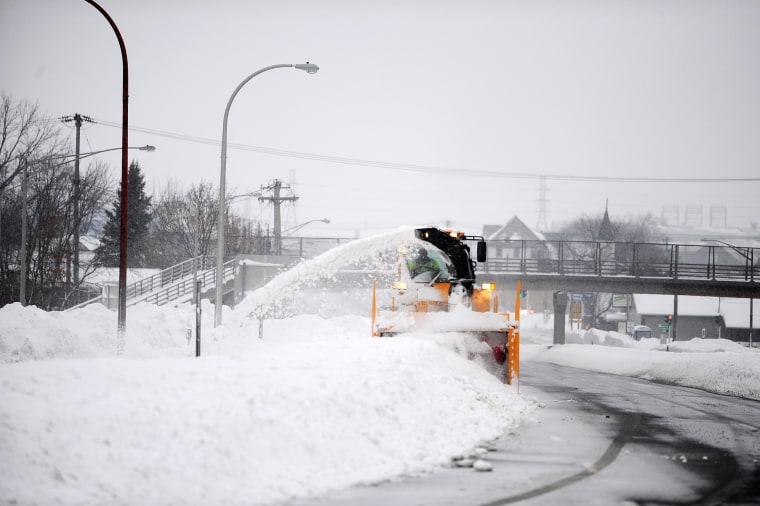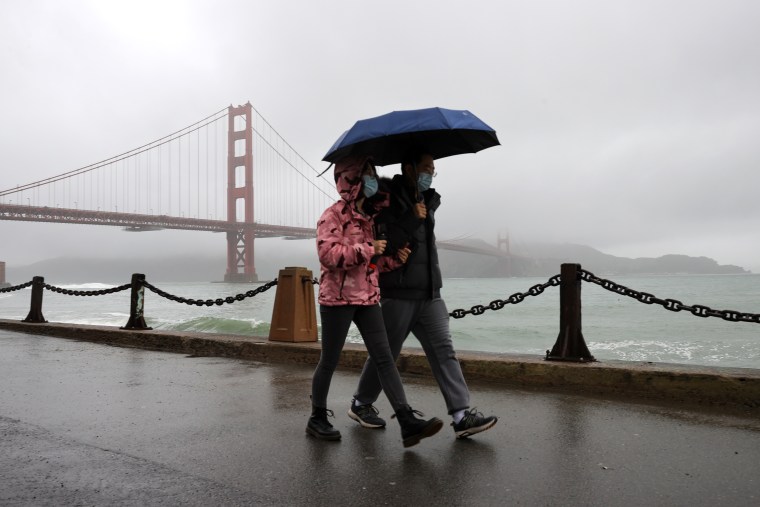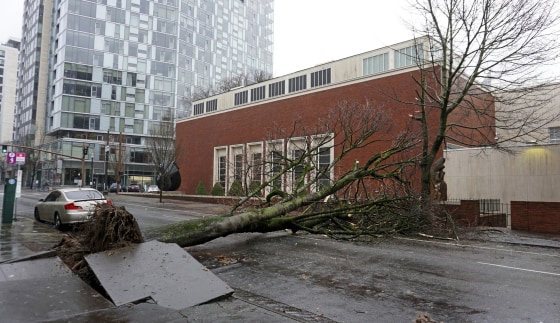Warmer weather is expected to spread across much of the United States over the next three days after a deadly winter storm that killed more than 60 people and walloped New York’s Erie County, while five separate storm systems are expected to bring double-digit rainfall and 3 feet or more of snow to the West through early next week.
Highs 5 to 20 degrees above average are expected through the holiday weekend in much of the country, which will help melt the snow in Erie County's Buffalo area and lead to a mild New Year's Eve and New Year's Day for most areas east of the Rockies.
Highs are expected to top 50 degrees in Washington, D.C., Denver and Atlanta on Wednesday, while Dallas could get highs in the high 60s and the low 70s Wednesday through New Year’s Day.
In Chicago, highs will be comparatively more moderate, in the low 40s Wednesday, potentially reaching 55 Thursday and stabilizing in the mid-40s Friday through New Year’s Day.
Buffalo sees relief
In Buffalo and Rochester, New York, temperatures are expected to reach the mid-40s Wednesday and continue climbing to the low-50s by Friday, according to the National Weather Service.
Erie County Executive Mark Poloncarz told reporters Wednesday morning that local officials are working with state officials to prepare for "a rapid melt over the next two days" and "the possibility of flooding," including possible ice jam flooding on creeks.
He also said the area's death count had increased to 34, with 26 people confirmed dead in Buffalo, seven in the suburbs and one in an unknown area. Two men and a woman have not yet been identified, he said.
The storm was Buffalo's deadliest in decades. The historic blizzard of 1977 killed as many as 29 people.
Emergency medical personnel were conducting wellness checks Wednesday in response to 911 calls that came in during the blizzard for homes they previously couldn't reach, Poloncarz said. In addition, the National Guard began going door to door for wellness checks Wednesday in all neighborhoods that lost power.
"We are fearful that there are individuals who may have perished living alone or two people who were not doing well in an establishment, especially those that still don't have power. … If your neighborhood lost power, you’re going to see a member of the National Guard starting now through the next 48 hours who's going to knock on your door," he said.
The region has already had some relief from the winter storm that left thousands of customers without power and digging out of several feet of snow: Tuesday night marked the first time in over a week that the Buffalo area was under no winter weather warnings, the National Weather Service Buffalo tweeted.
Buffalo Niagara International Airport, which has been closed since Friday, was expected to reopen Wednesday morning, the airport tweeted.
A driving ban for Buffalo remained in effect Wednesday morning. More than 60% of all city streets had at least one lane available for emergency vehicles Wednesday morning, and state and local officials are aiming to increase the number to 100% by the end of the day, officials said.
Officials said 119 dump trucks and more than 72 high lifts are being used to clear the roads throughout the county. More than 450 pieces of equipment were on Buffalo streets, police tweeted.
Mayor Byron Brown told reporters Wednesday morning that 95% of main roads and 75% of secondary streets have been cleared and that 50% of residential streets have had first passes.
But Poloncarz said that the city has not worked to clear the streets quickly enough and that the county would consider taking on that responsibility in another intense storm.
"I’m sick of it. ... I live in the city of Buffalo, and it pains me to see the 25 towns and two small cities opened in times when the city isn’t," he said. "The city has its own problems that are different than the smaller communities, because of the size of the streets and the parking issues. I understand that, but we have more capabilities than the city. And if we have to, working with the state, we will find a way to get through these storms quicker by taking over operations if need be. And I know the mayor’s probably not thrilled to hear it. I don’t care anymore. I want it done."
Asked for comment, the mayor's office referred to the mayor's news conference when, in response to reporters' questions about Poloncarz's comments, Brown said that he had not yet heard them but that the two had been in communication both by phone and in person and that Poloncarz did not make the comments to him directly.
More than 2,100 customers in New York state were without power Wednesday afternoon, according to PowerOutage.us.

Power was being restored in Erie County, with 969 of its approximately 440,400 energy customers remaining without power late Wednesday morning, compared to more than 2,000 who were without power Tuesday night.
National Grid — whose customers have all but two of the power outages in the county, according to PowerOutage.us — was aiming to restore at least 95% of the outages in the county by the end of Wednesday, Poloncarz said.
Anyone in New York who lost power for 72 hours or more is eligible under state law to be reimbursed by National Grid or New York State Electric and Gas for the costs of spoiled food or prescription medications, he added.
Storms to batter the West Coast
Meanwhile, five separate storm systems will affect the West through Monday.
A storm system is expected to bring snow and wind gusts up to 70 mph to the Rockies and the Four Corners regions Wednesday.
On Thursday, the next storm system makes its way to the West Coast, with a flood risk developing across parts of California. On Friday, a storm system will continue to bring coastal rain and heavy mountain snow.
By the time the storms move through the West, double-digit rainfall totals and 3 feet of snow or more will have fallen.
Stormy weather has already affected parts of the West.
In the Northwest, monster waves, high tides and strong winds battering western Oregon and Washington led to fatal crashes, power outages and flooded homes Tuesday and early Wednesday.
NBC affiliate KGW of Portland, Oregon, reported that five people were killed Tuesday in three crashes across the northern part of the state, on Interstate 84 and Highway 26, that involved either striking a tree or trees falling on moving vehicles.
Both roadways were closed for hours before they reopened Tuesday night, according to KGW.
Oregon State Police didn't immediately respond to a request for more information.

In Washington, high tides known as king tides and heavy rains caused water to spill into more than a dozen homes in Seattle’s South Park neighborhood, The Seattle Times reported.
As of Wednesday afternoon, Oregon led the country as the state with the most reported power outages — with more than 57,000 customers affected, down from more than 66,000 in the morning — according to PowerOutage.us.
In the northwest part of the state, more than 10,900 customers in Clackamas County and more than 10,800 customers in Tillamook County were without power Wednesday morning. Thousands more in Yamhill, Polk and Linn counties were also without power, according to PowerOutage.us. In the southwestern part of the state, 3,800 customers were without power in Josephine County.
In Washington, more than 13,500 people in King County were without power Wednesday morning, as were thousands more in Kitsap and Thurston counties in the western part of the state, according to PowerOutage.us.
Along Oregon’s north coast, winds hit 80 mph Tuesday. In the Portland metro area, gusts of 60 mph downed powered lines and felled trees, some of them near the Portland Art Museum downtown.
Coastal flooding and high wind advisories were also in effect for much of western Washington.
A record high tide of 18.4 feet submerged parts of the state capital, Olympia, sweeping marine life into the city’s streets, officials said.
“Jellyfish washed over the shoreline and into our streets,” Olympia Water Resources Director Eric Christensen said. “There was a woman who was kind enough to rescue them and put them back into Budd Inlet.”
Other areas around Puget Sound also got flooded, trapping cars and affecting buildings.
The weather also forced the full or partial closure of several Oregon state parks at a time when whale watchers and holiday tourists typically flock to the coast.
Oregon State Parks announced emergency closures for Ecola and Cape Meares because of high winds and the potential for falling trees. The day-use area at Sunset Bay State Park near Coos Bay was closed because of extreme high tides and flooding.
Cape Meares is one of 17 sites hosting Oregon’s Whale Watch Week, which is returning in person this year for the first time since the coronavirus pandemic began. During the event, which starts Wednesday and lasts through Sunday, volunteers help visitors spot gray whales during their annual migration south.
The park expects to reopen Wednesday, but people are advised to visit later in the week if possible, Oregon State Parks spokesperson Stefanie Knowlton said.

The first in a week of storms brought powerful winds, rain and snow to California on Tuesday, substantially lowering temperatures that had topped 80 degrees in some areas over Christmas.
There were numerous reports of roadway flooding and downed trees and branches as the storm blew into the northern half of the state and spread south, the weather service said.
More than 8,200 California energy customers were without power Wednesday morning, with Humboldt County reporting the most outages, at more than 3,100. Mendocino County, just south of Humboldt, had nearly 700 outages, according to PowerOutage.us.
Winter storm warnings were issued for the Sierra Nevada, where motorists were advised that travel could be hazardous. Chains or snow tires were required on some highways.
Gusts up to 120 mph were recorded on some Sierra ridgetops, the Reno, Nevada, weather office said. Backcountry avalanche warnings were issued for parts of the mountain range.


